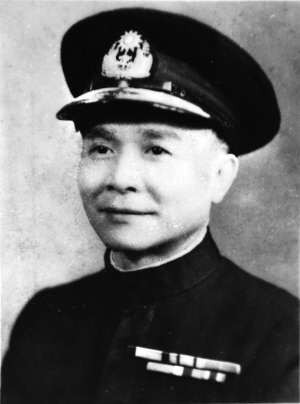Chan Chak facts for kids
Quick facts for kids
Chan Chak
|
|
|---|---|
|
陳策
|
|
 |
|
| Personal details | |
| Born | 2 April 1894 Fujian, Qing Dynasty |
| Died | 31 August 1949 (aged 55) Guangzhou, Guangdong, Republic of China |
| Awards | Medal of Victorious Garrison - First Class (Republic of China) Knight Commander of the Order of the British Empire (KBE) |
| Military service | |
| Allegiance | |
| Branch/service | |
| Rank | |
| Battles/wars | Warlord Era Second Sino-Japanese War World War II Pacific War Battle of Hong Kong |
| Chan Chak | |||||||||||
|---|---|---|---|---|---|---|---|---|---|---|---|
| Traditional Chinese | 陳策 | ||||||||||
| Simplified Chinese | 陈策 | ||||||||||
|
|||||||||||
Andrew Chan Chak KBE (Chinese: 陳策; 2 April 1894 – 31 August 1949) was a brave Chinese admiral. He was part of the Republic of China Navy. He is best known for his amazing escape from Japanese occupation of Hong Kong on Christmas Day in 1941. He led five British torpedo boats to safety.
Contents
A Life of Service
Chan Chak was born in Hainan, China. He started his naval career as a Midshipman in Guangzhou. This was during the last years of the Qing Dynasty. He strongly believed in a new, modern China.
During a time called the Warlord Era, Chan Chak took part in many naval battles. These battles happened in Southern China. In 1923, he became the Commander-in-Chief of the Guangdong Fleet. This fleet was later renamed the 4th Fleet of the Republic of China Navy.
Facing the Japanese Invasion
When the Second Sino-Japanese War began, Chan Chak was given more duties. He became the Commander of the Fortresses of Humen. In 1938, during a battle there, his left leg was badly hurt. Sadly, his leg had to be removed.
In 1939, Chan Chak, who was then a Rear Admiral, went to Hong Kong. His job was to be a special officer for the Chinese government. He pretended to be a stockbroker. This helped him secretly move important supplies into China. This was difficult because Japan was blocking the area. He also worked with British officials in Hong Kong. He helped keep the local Chinese people on their side. He also helped find people who supported Japan.
The Great Escape from Hong Kong
On December 8, 1941, the Battle of Hong Kong started. On Christmas Day, the Governor of Hong Kong decided to surrender to the Japanese. Chan Chak chose to escape Hong Kong. He was given command of the five remaining Royal Navy torpedo boats.
A Daring Plan
Chan Chak and his group got on a small boat called Cornflower II. They were heading to meet the torpedo boats. But Japanese forces fired at their boat. Chan Chak quickly ordered everyone to leave the ship. He took off his artificial leg. He was then shot in his left wrist. He could barely swim with only one arm and one leg. He even gave his life jacket to his bodyguard, who could not swim.
His helper, Lieutenant-Commander Henry Hsu, bravely pulled him to shore. The torpedo boats then arrived to rescue them. They sped towards Mirs Bay. From there, the escapees walked for four days. Chinese fighters helped them through areas controlled by Japan. They finally reached Huizhou in China, which was not occupied by Japan.
Heroes of the Escape
In total, 68 British, Chinese, and Danish people were saved. This included intelligence officers, naval staff, and marines. For helping these British military people escape, Chan Chak was given a special honor. He was made an honorary Knight Commander of the Order of the British Empire in 1942.
Later Life
From September 1945 to June 1946, Chan Chak served as the Mayor of Guangzhou. He passed away in Guangzhou on August 31, 1949. He died from a stomach ulcer during the final weeks of the Chinese Civil War.


